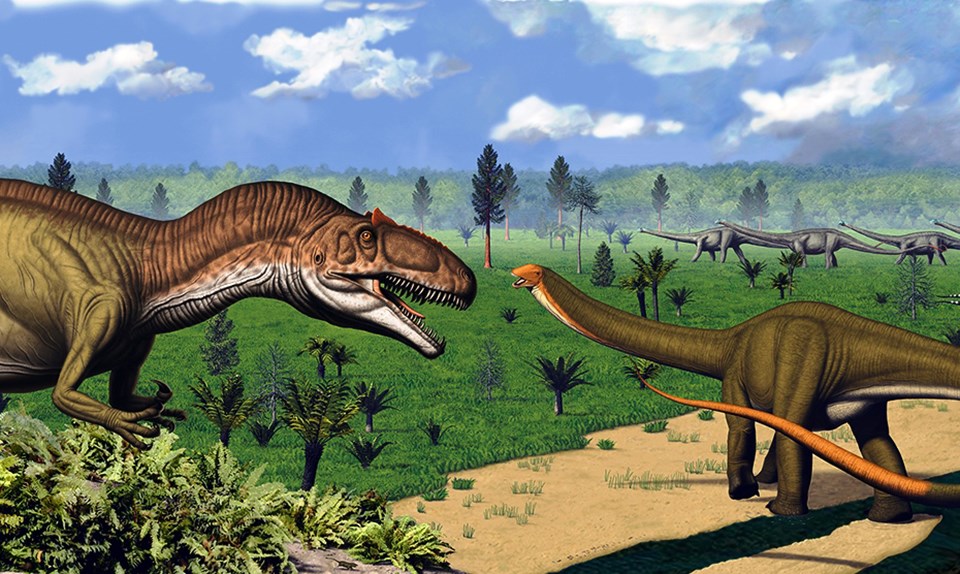
NPS image.
Introduction
The western United States has one of the most famous of all geologic formations: the Morrison Formation. The Morrison Formation was deposited during the Late Jurassic, between approximately 157 and 150 million years ago, across rivers, floodplains, lakes, and other environments. At this time North America was farther south and the Rocky Mountains did not yet exist. Flowering plants had not yet evolved; instead, the land was covered by ferns, cycads, and horsetails, with stands of conifer trees, ginkgoes, and tree ferns. Freshwater mussels and snails thrived in the rivers and lakes, which were also populated by fishes, turtles, and crocodile relatives. On the land, immense sauropod dinosaurs, plated stegosaurs, and beaked ornithopods browsed and grazed while avoiding carnivorous theropod dinosaurs. Much smaller amphibians, lizards, lizard-like reptiles, mammals, and mammal cousins foraged around these giants, while insects and pterosaurs flew by.
Discovery
We have no way of knowing when people first observed fossils in the rocks of the Morrison Formation. The first scientifically studied discovery may be bones of the sauropod Dystrophaeus from southeastern Utah, found in 1859, although not all geologists agree that the rocks belong to the Morrison Formation. Study of the Morrison Formation took off with finds in three places in early 1877: Garden Park, Colorado; Morrison, Colorado; and Como Bluff, Wyoming. These finds were reported to Edward Drinker Cope and Othniel Charles Marsh, a pair of prolific vertebrate paleontologists who were in competition. They helped spur the “Bone Wars” between Cope and Marsh, who soon had people working to excavate dinosaur bones and other fossils in Colorado and Wyoming. Many famous dinosaurs were named from these discoveries, including the carnivores Allosaurus, Ceratosaurus, Coelurus, and Ornitholestes; the sauropods Apatosaurus, Brontosaurus, Camarasaurus, and Diplodocus; the bipedal beaked herbivores Camptosaurus, Dryosaurus, and Nanosaurus; and the stegosaur Stegosaurus. (Many less-famous dinosaurs were also named, because Cope and Marsh were working very quickly. Ever heard of Atlantosaurus or Tichosteus?)
Because the Morrison Formation rocks are widely distributed and often have fossils, people have continued to explore its outcrops and frequently make new discoveries. In fact, so many fossils have been collected that some important specimens were unstudied for decades, or published once and then forgotten for many years until someone went back to look at the material. One of the most famous dinosaur quarries is the Carnegie Quarry at Dinosaur National Monument, and one of its most famous specimens is a nearly complete skeleton of Apatosaurus, excavated in the early 20th century. A skull was found near this skeleton but was ignored because most of the paleontologists of the time didn’t think it was the right shape to belong to it. Fifty years later, new study showed that this skull did belong to Apatosaurus. Another early attempt to find a skull for Apatosaurus used a partial skull that, when studied a century later, turned out to belong to Brachiosaurus.
Visiting The Morrison
If you want to see the Morrison Formation, it can be found in many units of the National Park Service. Of course, there’s Dinosaur National Monument in Colorado and Utah, but visiting the Morrison will take you across several states:
-
Arches National Park, Utah—[Geodiversity Atlas] [Park Home]
-
Bighorn Canyon National Recreation Area, Montana and Wyoming—[Geodiversity Atlas] [Park Home]
-
Black Canyon of the Gunnison National Park, Colorado—[Geodiversity Atlas] [Park Home]
-
Capitol Reef National Park, Utah—[Geodiversity Atlas] [Park Home]
-
Colorado National Monument, Colorado—[Geodiversity Atlas] [Park Home]
-
Curecanti National Recreation Area, Colorado—[Geodiversity Atlas] [Park Home]
-
Devils Tower National Monument, Wyoming (probably only eroded remnants)—[Geodiversity Atlas] [Park Home]
-
Dinosaur National Monument, Colorado and Utah—[Geodiversity Atlas] [Park Home]
-
Glacier National Park, Montana—[Geodiversity Atlas] [Park Home]
-
Glen Canyon National Recreation Area, Arizona and Utah—[Geodiversity Atlas] [Park Home]
-
Grand Teton National Park, Wyoming—[Geodiversity Atlas] [Park Home]
-
John D. Rockefeller, Jr., Memorial Parkway, Wyoming—[Geodiversity Atlas] [Park Home]
-
Hovenweep National Monument, Colorado—[Geodiversity Atlas] [Park Home]
-
Old Spanish National Historic Trail, Arizona–California–Colorado–Nevada–New Mexico–Utah—[Park Home]
-
Wind Cave National Park, South Dakota—[Geodiversity Atlas] [Park Home]
-
Yellowstone National Park, Idaho, Montana, and Wyoming—[Geodiversity Atlas] [Park Home]
Some other famous sites are also recognized as National Natural Landmarks:
-
Cleveland-Lloyd Dinosaur Quarry National Natural Landmark, Utah
-
Como Bluff National Natural Landmark, Wyoming
-
Garden Park Fossil Area National Natural Landmark, Colorado
-
Morrison-Golden Fossil Areas National Natural Landmark, Colorado
Site Index and Credits
Age of Dinosaurs (2021)
Text by Justin Tweet (AGI). Contributors: Vincent Santucci (GRD), Adam Marsh (PEFO), ReBecca Hunt-Foster (DINO), Don Corrick (BIBE). Project Lead / Web Development, Jim Wood (GRD).
References
-
Tweet, J.S. and V.L. Santucci. 2018. An Inventory of Non-Avian Dinosaurs from National Park Service Areas. in Lucas, S.G. and Sullivan, R.M., (eds.), Fossil Record 6. New Mexico Museum of Natural History and Science Bulletin 79: 703-730. https://irma.nps.gov/DataStore/Reference/Profile/2257153
-
Santucci, V.L., A. Marsh, W. Parker, D. Chure, and D. Corrick, 2018. “Age of Reptiles”: Uncovering the Mesozoic Fossil Record in three Intermountain national parks. IMR Crossroads. Spring 2018, p. 4-11. https://irma.nps.gov/DataStore/Reference/Profile/2253529
Last updated: July 8, 2022
